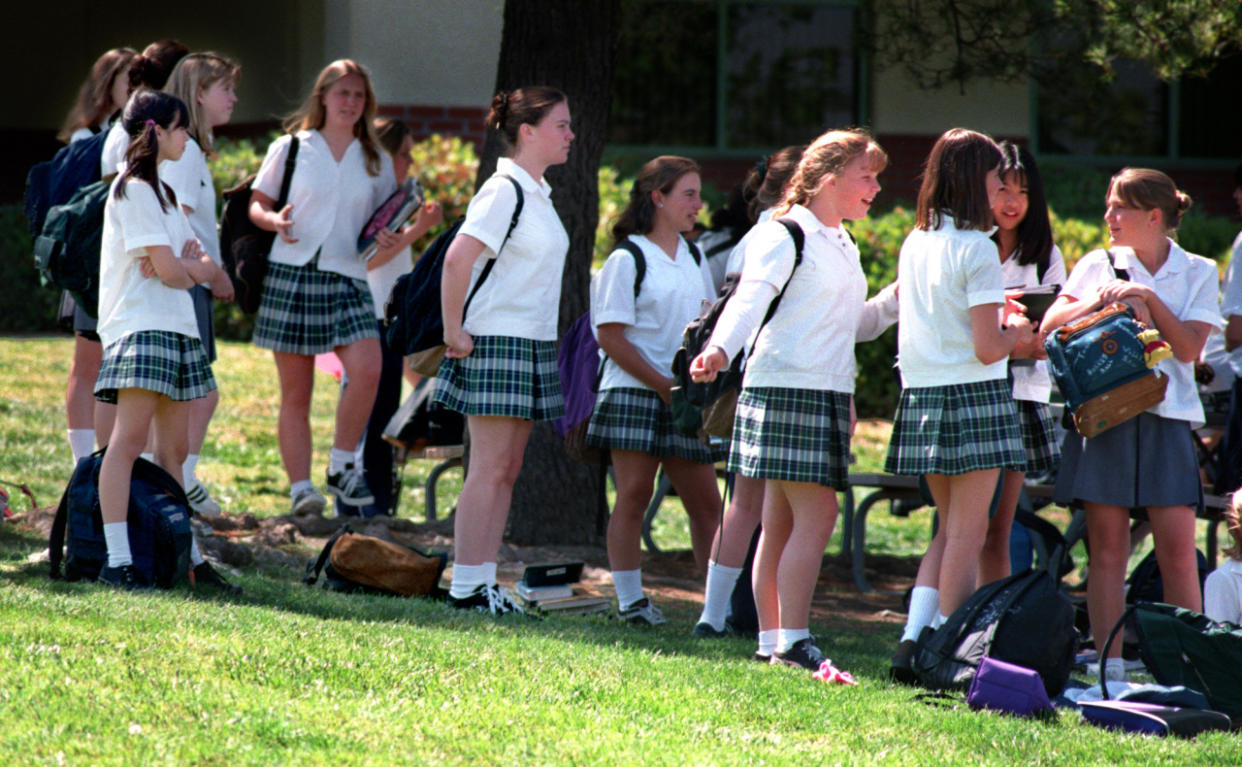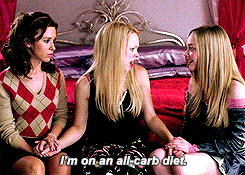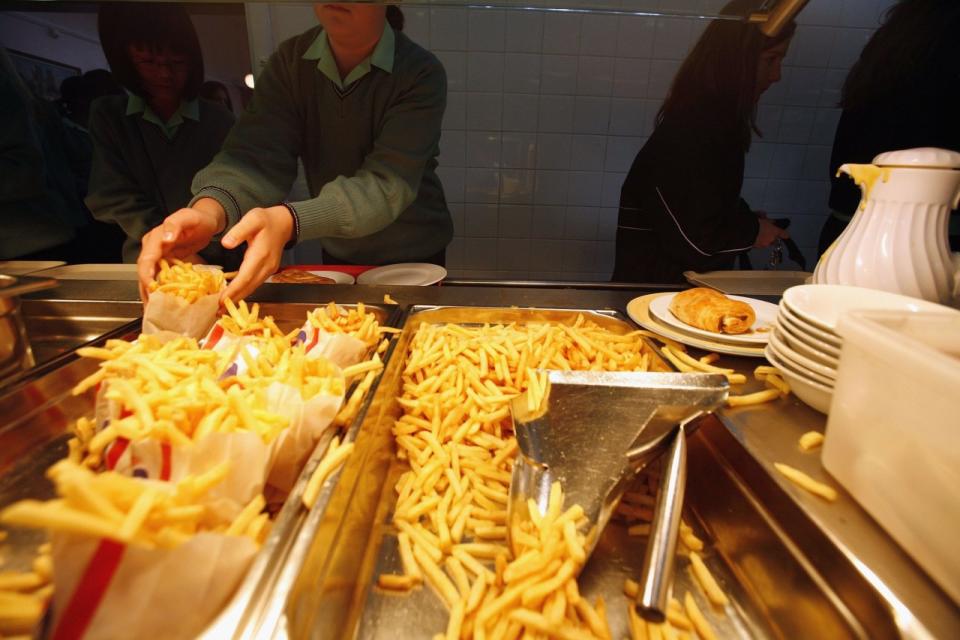My Body Education, Or, How I Learned to Not Give a Crap About Random Body Standards

Girls all lined up. (Photo: Getty Images)
Coming to terms with how your body looks is something we all as humans go through, but when you live between two worlds and two different body ideals, the journey to personal acceptance can be a bit more fraught.
Before attending an all-girl’s private school on the Upper East Side in 7th grade, I was just another student at my local public school in the North Bronx. The neighborhood I grew up in was largely populated by Caribbean immigrants and their first-generation American-born children. As a tween, when my body was developing, I got a lot of different messages regarding how my body should look. As I approached puberty and my body began to change, I remember doing standing side-crunches, after hearing my mother talk about how cute a nipped, shapely waist was. I saw her hourglass figure and I wanted to look just like her, so I would spend a few minutes per day in the mirror trying to snatch my waist that had barely even began to take form. Needless to say, my obliques were poppin’ back then.
By the time I had entered middle school, which I attended locally in the Bronx, I was already very aware of what was deemed a “nice” body within my community. The school I went to had children of all backgrounds and ethnicities, but the overall reigning standard of beauty was heavily influenced by the multi-ethnic black and Latin cultures that were in strong representation at the school. I was in 6th grade around the time Sisqo’s 1999 hit “Thong Song” came out, and I knew “dumps like a truck,” or, having a big butt was in. Not that it was never not a desirable trait in my culture. Growing up, the message in my community was women were supposed to be thick (but not “fat”) and curvaceous – they were to have ample thighs, a small waist, large, perky breasts, a flat stomach and a high, round booty that was more bubble-shaped than it was wide.

Thanks for adding to all my confusion, Sisqo. (Photo: Bunnosaur)
It sounds a lot like the popular body standards we have today, now that mainstream America has caught up to what were once considered “niche” preferences, thanks in part to the rise of Jennifer Lopez in the early aughts, and now the popularity of curvy caucasian women like Kim Kardashian. But by the time I had started private school, that particular body shape wasn’t one that many of my classmates found aspirational.
I was always a small person – born small, in fact. Throughout my childhood, I got a lot of comments on about how small I was. “Your hands are so tiny,” my fellow classmates would tell me. “Aw, your feet are so small, you still have your baby feet,” my mother would say. I was always one of the shortest kids in my class. I was always getting hand-me-downs from my cousin who was two years younger than me and growing out of her clothes at record speed. But I never thought I was fat until I went to private school.
Besides the fact that I was coming from a lower middle class neighborhood, and being thrust into a school environment with girls whose parents owned several homes and had more money than I could fathom at the time, noticing all the other cultural differences between me and my classmates was unavoidable. Back in my neighborhood, the girls my age were listening to Lil’ Bow Wow. On the Upper East Side, my classmates fawned over Aaron Carter. (Looking back, I realized all of us had crappy taste in music.) In the Bronx, my friends and I would tune in to Hot 97′s then hosts Star and Bucwild. At private school, it was Z100′s Elvis Duran and the Z Morning Zoo. But what stood out most to me is how my classmates obsessed over their bodies.
Instead of thick thighs, these girls wanted them to be thinner. Instead of large breasts, girls were trying to minimize their busts. Sure, J.Lo was curvy, but Mary-Kate and Ashley Olsens’ diminutive, waif-like figures were very in vogue. Curvier girls couldn’t pull off all those billowing layers, after all. At first, I chose to exist outside the body standard my private school classmates put forth. But it was in vain. In no time, it was clear that my schoolmates’ personal body issues were influencing me. I realized what effect that environment had on me when I ran into an old public school classmate one afternoon in 7th grade. After I greeted my friends, she slapped the part of my thigh exposed by my school skirt. “You getting thick, Ji!” she said smiling. Instead of taking the compliment I said nothing and spent the rest of the day wondering if I was fat or not.

I would have recoiled at the thought in high school, but now an all-carb diet doesn’t sound too bad. (Photo: Thank God for Gravity)
As I continued through middle and high school, I realized I was living in two worlds. At my predominantly white high school, the pressure to be as thin as possible was palpable. At one point, I had decided to go on a diet I made up, the 5-a-day diet, in which I would only eat 5 things per day, or 5 “points” a day. The points were arbitrary and to this day I don’t 100% understand how I assigned value to certain foods or meals. At breakfast, I would have an orange (1), a salad (counted as one since I figured lettuce was mostly water) and whatever my mom made for dinner counted as three. I was hungry. I was hangry. But I wasn’t any slimmer. I ditched the diet and instead obsessively did 100 crunches three nights a week so that my stomach would at least be flat. It never was.
It wasn’t until my junior year in high school that I began to realize that maybe I wasn’t as “fat” as I thought I was – or at least not fat enough to make the boys I was interested in (who happened to be mostly young men of color) recoil in disgust of my flabby body. They didn’t mind that my thighs touched or that my stomach wasn’t completely flat. And they definitely weren’t mad at my sizable rear – but then again neither was I. Still, I never felt as willowy and slim as the other girls in my class – in spite of the positive feedback I got from the opposite sex, I still yearned for a thigh gap, a flat stomach, and arms that were less flabby and more toned.
It was all very confusing – being stuck between two worlds, looking to fit an ideal that was acceptable in a majority white, wealthy private school setting, but was still appealing to the black and brown boys I socialized with. After graduating high school and going onto college, I started to ease up a bit more about my body, though I still held strong to both standards in the back of my mind.

Fries might have been 5 points on my 5 point scale in high school. (Photo: Getty Images)
It wasn’t until my junior year in college when I stopped trying to appeal to both standards. I had returned to my school in Ohio from an idyllic semester abroad in Jamaica. It was cold. It was gray. I had my appendix taken out. There was no more sun, no more handsome men with locs and toned arms. I longed for my days in Kingston, as dangerous as it sometimes was. I fell into a bout of depression, which combined with my minor surgery, made me lose several pounds. I was the smallest I’d been since middle school. My butt was not as large, but my stomach was less pronounced and my thighs were smaller. A few friends of mine at the school commented on my apparent weight loss. “You too skinny, boo. You need to eat some rice and beans.”
That comment didn’t hurt my feelings at all. Instead, it brought up the same confusing feelings I had as a tween and teenager. But then and there, I decided that I was too old to feel confused or bad about myself anymore. Why did I even care what people thought about the way I looked? And why did I spend time trying to live up to everyone’s differing opinions of what I should look like, instead of just figuring out what I wanted for myself?
Whether they favor a thick or thin from, body standards imposed by society are going to be mostly unattainable by nature. Instead of chasing an ideal that will never please anyone, the focus should be on creating your own ideal and not giving a crap what anyone else has to say about it.
Follow us on Instagram, Facebook, and Pinterest for nonstop inspiration delivered fresh to your feed, every day.
